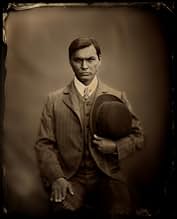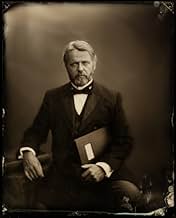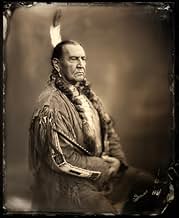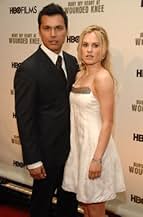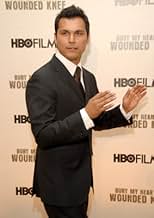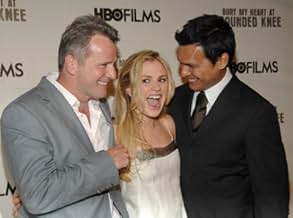Enterre mon coeur à Wounded Knee
Ajouter une intrigue dans votre langueA historic chronicle based on the book by Dee Brown explains how Native Americans were displaced as the United States expanded west.A historic chronicle based on the book by Dee Brown explains how Native Americans were displaced as the United States expanded west.A historic chronicle based on the book by Dee Brown explains how Native Americans were displaced as the United States expanded west.
- Réalisation
- Scénario
- Casting principal
- Récompensé par 6 Primetime Emmys
- 29 victoires et 31 nominations au total
- One Bull
- (as Nathan Chasing Horse)
Avis à la une
Wanting revenge for what turned out to be the worst defeat that the US Calvary suffered in the Indian Wars the "Great White Father" President Ulysses S. Grant, Fred Thompson, sent a much bigger military detachment headed by, as he's called by the Sioux, Gen.Bear-Coat to put a final end to the Dakota Indian uprising. Confronting Chief Sitting Bull, August Schellenberg, and his some three thousand warriors at Ceder Valley Creek Gen. Bear-Coat had no trouble dispersing the Sioux onslaught mowing down hundreds of Sitting Bull's men with volleys of rifle and cannon fire.
Dispersed and on the brink of starvation Sitting Bull's rival Chief Red Cloud, Gordon Tootoosis, was forced to sign away his peoples rights to where they became wards of the state living off the kindness and charity of the hated White Man. Sitting Bull wanting none of this took his followers to Canada where after suffering through a number of harsh Canadian Winters, far worse then any of the winters in the Dakota Territories, later came back hat in hand accepting the unthinkable: living under the White Man's both rule and law. It was the deception and manipulation by the US Government in trying to force Sitting Bull and his people to sign away their ancestral lands that eventually lead to the wild and hysterical events that lead to Wounded Knee.
The story of "Bury My Heart at Wounded Knee" is told to us through the personal observations of Charles Eastman, Adam Beach, formerly known by his Sioux Indian name of Ohiyesa. Eastman was an 18 year old at the battle of Little Big Horn where he earned his warrior's feather in killing a horse soldier of Gen. Custer's 7th Calvary in the fighting. Now grown up and earning a medical degree Eastman only wants to help his fellow Sioux in preventing a number of deadly outbreaks of disease that hit his former home the Pine Ridge Indian Reservation.
Together with his white European wife the former Elaine Goodale, Anna Paguin, Eastman worked around the clock trying to save what he could of the many Sioux Indians who were dying by the hundreds of both hunger and disease. With Eastman's good friend Massachusetts Senator Henry Drew, Alden Quinn,trying to get his people to come to some agreement with the US Government in becoming farmers instead of nomads, which the Sioux were for countless centuries, tensions soon reached a breaking point.
It was when out of sheer desperation the Sioux adopted the ancient Indian Ghost Dance, which was only ceremonial and nothing else, that the US Army was dispatched to put an end to what the Federal Government back in Washington D.C perceived to be another potential Little Big Horn. With tempers flaring on both sides after Chief Sitting Bull was murdered by the reservations Sioux police it was only a matter of time for the lid, that both Eastman and Senator Drew tried to keep on, blew off and the results was the massacre at Wounded Knee. The last major battle between the US military and American Indians in the long and bloody US/Indian Wars of the 1800's.
Pretty accurate film about how the American Indians were treated and how they had their land which they never really claimed to own, the idea of a person owning a piece of land was unknown to them, from right under noses. Despite the many losses they suffered at the hands of the US Military the Sioux never relinquished their claim to the Black Hills, which they considered their sacred and holy grounds. Technically and legally even now, some 118 years after the Wounded Knee massacre, the historic Black Hills are in the hands of the Sioux tribes still living there.
P.S Charles Eastman aka Ohiyesa was to write dozens of books and articles about his people the Sioux Indians as well as practice medicine at the Pine Ridge, as well as other, Indian reservation until he passed away on January 8, 1939 at the age of 80. Eastman among his many accomplishments in the service of his people was also the co-founder of the American Boy Scouts that improved and enriched the lives of American youths white black yellow and Native American Indian alike.
The entire production flags because of the TV aspect, many of the film shots losing their impact either because of lack of attention to detail or funds (or probably both). Either way this could've been an extreme visual recollection for most viewers but instead it lacks the depth I would've liked to have seen.
Regardless, there are some stellar appearances and acting within it. August Schellenberg as Sitting Bull undeniably has the most impact. Recent movie viewers will probably remember him from his portrayal as Powhatan in THE NEW WORLD. The contrast between the character in The New World and here in Wounded Knee shouldn't be lost, either. Without Powhatan and Pocahontas, the white settlers at Jamestown would've perished within the first few winters. And now, in Wounded Knee, it is the white man who destroys what is left of Native American life; a terribly stark (and bloody) reality.
The other notables are Adam Beach (FLAGS OF OUR FATHERS) as Charles Eastman, and Aidan Quinn as Senator Henry Dawes. They spend a lot of time together on film and they played against/off each other exceptionally well. Charles being the "new wave" Indian who melds into the white man's way of life until exposed to reservation life at Pine Ridge. Henry Dawes seeing himself as "The Great White Savior Of The Indians" by passing legislation that loops a few nooses around the necks of the Plains Indians' way of life without even realizing it.
But other actors have little to offer. Anna Paquin (X-MEN) as Charles' white love interest (and eventual wife) is seen too infrequently so the relationship between the two has little impact. She does a good job of acting but the script stymied any possibility of real success. From here the acting dips into the drab and boring. I have to give mention to Senator Fred Thompson (currently a Republican runner for the U.S. Presidency) who plays President Ulysses S. Grant. We see maybe four frames of film with him in it and then he's gone. This surprised me greatly since it was Grant's administration that doomed Native Americans by rounding them up and placing them on reservations.
Despite my misgivings about the script, cinematography and acting, this is a vital story that needs to be told, and it isn't something that is normally taught in grade school or higher. Europeans (us) conquered this land and its people, and pushed them into holding pens where they, to this day, await justice for our multiple treaty violations and massacres of their men, women and children (I will say that the scenes depicting large-caliber rifle bullets ripping through young kids was filmed well and was equally hard to watch).
So the story gives this film a higher rating than anything within it, which is unfortunate, as this terrible moment in American history needs to be remembered just as much as Germany needs to remember its holocaust.
Starting off where most movies end, at a CGI created overhead shot of The Little Big Horn (!), this instead focuses on the final years of the Unions war against the Indian nations, culminating in the massacre at Wounded Knee.
There's a really great role for Adam Beach, as a young Souix doctor, who's father turned his back on the native ways and sent him to live amongst whites at a young age, stripping him of his identity.
August Schellenberg is excellent here as Sitting Bull, who's determination and pride stokes the anger of the powers that be, including Aiden Quinn, a sympathetic but patronizing Senator who has taken it upon himself to lead the Indians on a path to "civilization".
Anyone who watched the myriad Cavalry pictures and Little Big Horn epics should see this and find out how the whole sad story ends.
Le saviez-vous
- AnecdotesAugust Schellenberg previously played Sitting Bull in both Witness to Yesterday (1973) and Crazy Horse, le plus grand d'entre nous (1996).
- GaffesThe newspaper story being viewed after the Custer battle (Virginia newspaper?) has a dateline of July 3, 1876. The first published account of the event was put out by the Bozeman newspaper (the Times?) on July 4, 1876. Late on July 4, (7:00 p.m.) the Helena newspaper produced a special, extra edition, and at this time, the AP correspondent relayed the material to Salt Lake City, where it was then distributed around the country. The "Virginia" newspaper of the July 3 date could not have contained the story. (Information from searches of archives on the Internet.)
- Citations
Col. Nelson Miles: Sitting Bull requested this council. We await his words.
Sitting Bull: Take your soldiers out of here. They scare the game away.
Col. Nelson Miles: Very well, sir. Tell me, then: how far away should I take my men?
Sitting Bull: You must take them out of our lands.
Col. Nelson Miles: What precisely are your lands?
Sitting Bull: These are the lands where my people lived before you whites first came.
Col. Nelson Miles: I don't understand. We whites were not your first enemies. Why don't you demand back the land in Minnesota where the Chippewa and others forced you from years before?
Sitting Bull: The Black Hills are a sacred land given to my people by Wakan Tanka.
Col. Nelson Miles: How very convenient to cloak your claims in spiritualism. And what would you say to the Mormons and others who believe that their God has given to them Indian lands in the West?
Sitting Bull: I would say they should listen to Wakan Tanka.
Col. Nelson Miles: No matter what your legends say, you didn't sprout from the plains like the spring grasses. And you didn't coalesce out of the ether. You came out of the Minnesota woodlands armed to the teeth and set upon your fellow man. You massacred the Kiowa, the Omaha, the Ponca, the Oto and the Pawnee without mercy. And yet you claim the Black Hills as a private preserve bequeathed to you by the Great Spirit.
Sitting Bull: And who gave us the guns and powder to kill our enemies? And who traded weapons to the Chippewa and others who drove us from our home?
Col. Nelson Miles: Chief Sitting Bull, the proposition that you were a peaceable people before the appearance of the white man is the most fanciful legend of all. You were killing each other for hundreds of moons before the first white stepped foot on this continent. You conquered those tribes, lusting for their game and their lands, just as we have now conquered you for no less noble a cause.
Sitting Bull: This is your story of my people!
Col. Nelson Miles: This is the truth, not legend. Crazy Horse has surrendered... with his entire band. And by his surrender, he says to you and your people that you are defeated. And by ceding the Black Hills to us, so say Red Cloud and the other chiefs, who demand that you end this war and take your place on the reservation.
Sitting Bull: Red Cloud is no longer a chief. He is a woman you have mounted and had your way with. Do not speak to me of Red Cloud!
Col. Nelson Miles: I suppose *you* are the only chief then. Sitting Bull is king of all the Indians! Now, humility is one of the four virtues of the Sioux chief. Sitting Bull shows his true nature now.
Sitting Bull: I have had my say with you.
Col. Nelson Miles: And I have had my say with you.
Sitting Bull: Then we will have a fight.
Col. Nelson Miles: So be it.
- ConnexionsFeatured in The 59th Annual Primetime Emmy Awards (2007)
Meilleurs choix
Détails
- Date de sortie
- Pays d’origine
- Site officiel
- Langue
- Aussi connu sous le nom de
- Bury My Heart at Wounded Knee
- Lieux de tournage
- Sociétés de production
- Voir plus de crédits d'entreprise sur IMDbPro
- Durée2 heures 13 minutes
- Couleur
- Mixage
- Rapport de forme
- 1.85 : 1

